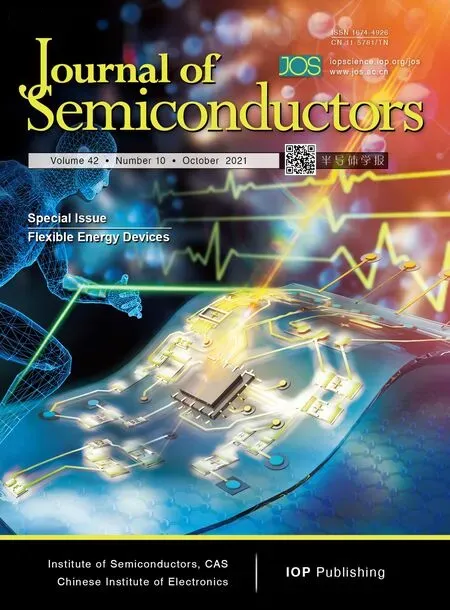Preface to the Special Issue on Flexible Energy Devices
Zhiyong Fan , Yonghua Chen, Yuanjing Lin , Yunlong Zi, Hyunhyub Ko, and Qianpeng Zhang
1Department of Electronic& Computer Engineering, The HongKong University of Science and Technology,Hong Kong999077, China
2Institute of AdvancedMaterials, Nanjing Tech University, Nanjing 211816, China
3School of Microelectronics, Southern University of Science and Technology, Shenzhen 518055, China
4Engineering Research Center of Integrated Circuits for Next-Generation Communications, Ministry of Education, Southern University of Science and Technology, Shenzhen 518055, China
5Department of Mechanical and Automation Engineering, The Chinese University of Hong Kong, Hong Kong 999077, China
6Energy and ChemicalEngineering, UlsanNational Instituteof Science and Technology,Ulsan 44919, Republic of Korea
Flexibleenergydevices arethe buildingblocks fornextgeneration wearable electronics. Flexible energydevicesare expected to have multiple functions, such as energy conversion from light to electricity and vice versa, energy generation from triboelectric, energy storage and so on. These functions can be efficiently realized by solar cells, light-emitting diodes(LEDs), triboelectricnanogenerators(TENG), batteries andsupercapacitors,etc. The flexible energy devices can be integrated into flexible, wearable, and/or portable platforms to enable wide application prospects in the fields of information, energy, medical care, national defense, etc. However, flexible energy devices face more challenges when compared to their rigid counterparts,which requiresmore breakthroughs andresearchefforts on fabrication techniques, materials innovation, novel structure designs, and deep physical understandings.
This special issue assembles 8 review articles providing a comprehensive summary of the latest development on flexible energydevices based onvarious technologiesand functionalsemiconductor materials. Briefly, Dong andWang have comprehensively reviewed and discussed the challenges of TENG-based self-charging power textiles that can become the future energy autonomy power sources[1]. The self-charging power textiles hybridizing fiber/fabric shaped batteries/supercapacitors are summarized fromtheaspect oftextile structural designs. Maet al. reviewed the flexible energy devices for wearablebioelectronics[2]. These flexible energy devices can be constructed in flexible platforms as the stable power supply for smart sensing, personalized healthcare, and robotics applications. More importantly, they summarized the existing challenges for flexibleenergy devices:mechanical stability,energy storagecapacityfor miniaturized devices, and biocompatibility. More specifically, Liet al.reviewedthe recent advances in zinc ion batteries (ZIBs)[3]. Because of the intrinsic safety, abundant storage, and low cost, the rechargeable aqueous ZIBs have become one of the most promising portable candidates for wearable energy storage deviceswith medicalandprimary safety. They alsosummarized the advances in overcomingthemost important challenges forZIBs, namelytherigid current collector and/or metal anode,easily detachedcathode materials, and therelativelynarrow voltage windowofflexibleelectrolytes. This timely review makes the ZIBs one step closer to commercial applications.
Zhuet al. delivered a timely review on the progress of efficient flexible solar cells made of nanostructures[4]. The nanostructures enhance the mechanical robustness of flexible solar cell devices while optimizing the light-trapping capabilities. Konget al. provided a focused discussion on the flexible perovskite solar cells (FPSCs)[5]. Considering the power conversion efficiency(PCE)ofFPSCs hasalreadyachieved21.1%,their thorough reviewonthe development offlexible substrates, carrier transport layers, perovskite films,and electrodesare highlyappropriate and enlightening. Moreover,theyalso pointed outthefuture work on FPSCscan befocused on the directions, such as large-area solar cells modules, environmental stability, and mechanical stability. Tanget al. reviewed the development of FPSCs from three aspects,namely the small-area flexible devices, roll-to-roll (R2R) processed devices with large scale, and emerging flexible cells with deformability and stretchability[6]. These deformable and lightweight FPSCs can be applied in wearableand portable electronicsas the power supply. Theirreview showsa pathwayto the high possibilityof commercializationofFPSCs for self-poweredsystems. On theotherhand, Yeet al. reviewed the recentadvancesontheasymmetric non-fullerenesmall molecule acceptors for polymer solar cells[7]. The advantages of asymmetric small molecules were discussed in three aspects: charge transport, molecular energy level, and active layer accumulation morphology. They also pointed out that the complicated synthesis of asymmetric small molecule acceptors (A-NF-SMAs) is still a critical problem that scientists need to address in the future.
Besides thesolar cellsdevices whichconvertlight energy toelectrical energy,thisspecial issuealso includesthereviewon blue perovskite LEDs for next-generationdisplays from Yoonet al., as one kind ofefficient energyconversion devices[8]. They summarized the three types of perovskite structures: perovskite nanocrystals (PeNCs), 2-dimensional (2D)and quasi-2D perovskites, and bulk (3D) perovskites.Moreover, they brought researchers’ attention to the remaining challenges of blue perovskite LEDs, namely the quantum efficiency ofthe emissive layer,the operational stability, and colorstability, by solvingwhich people can further boost the development of next-generation displays.
Wesincerelyhopethisspecialissue couldprovide the meaningful and profoundreview andperspective on the field of flexibleenergy devices.We would like to thankall the authors for their outstanding contributionsto this special issue. Weare alsograteful to theeditorial andproduction staff of theJournal of Semiconductorsfor their kind assistance.
 Journal of Semiconductors2021年10期
Journal of Semiconductors2021年10期
- Journal of Semiconductors的其它文章
- Side chain engineering on D18 polymers yields 18.74% power conversion efficiency
- Recent advances and prospects of asymmetric non-fullerene small molecule acceptors for polymer solar cells
- Voc deficit in kesterite solar cells
- Flexible perovskite solar cells: Materials and devices
- Progress in flexible perovskite solar cells with improved efficiency
- Recent progress of efficient flexible solar cells based on nanostructures
